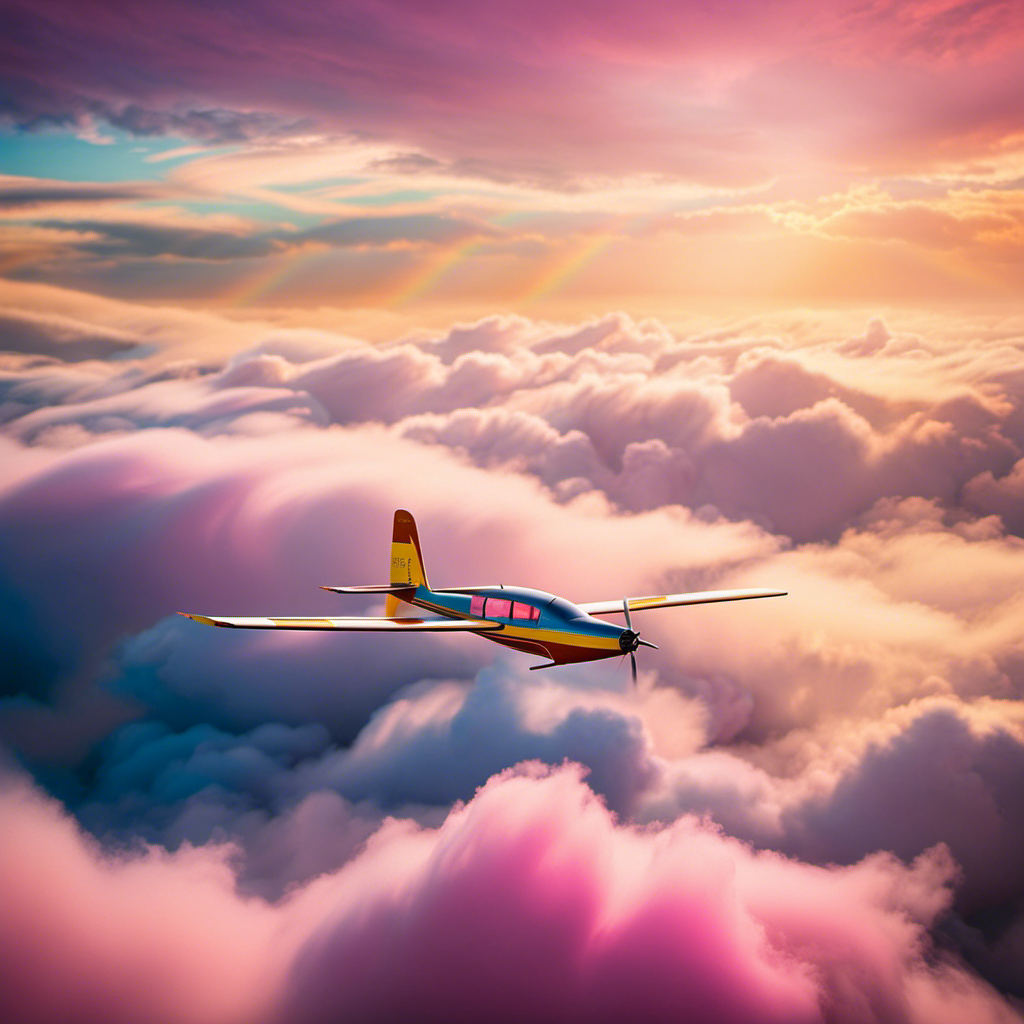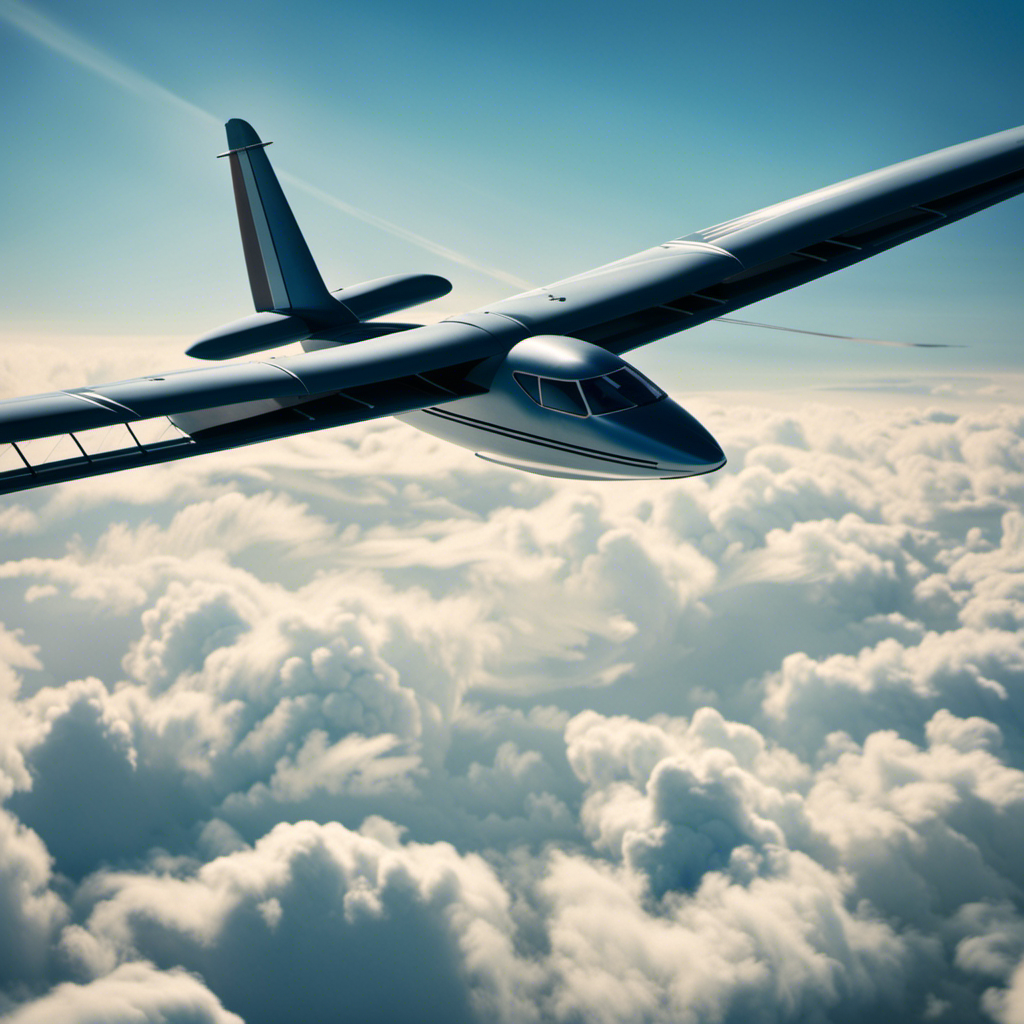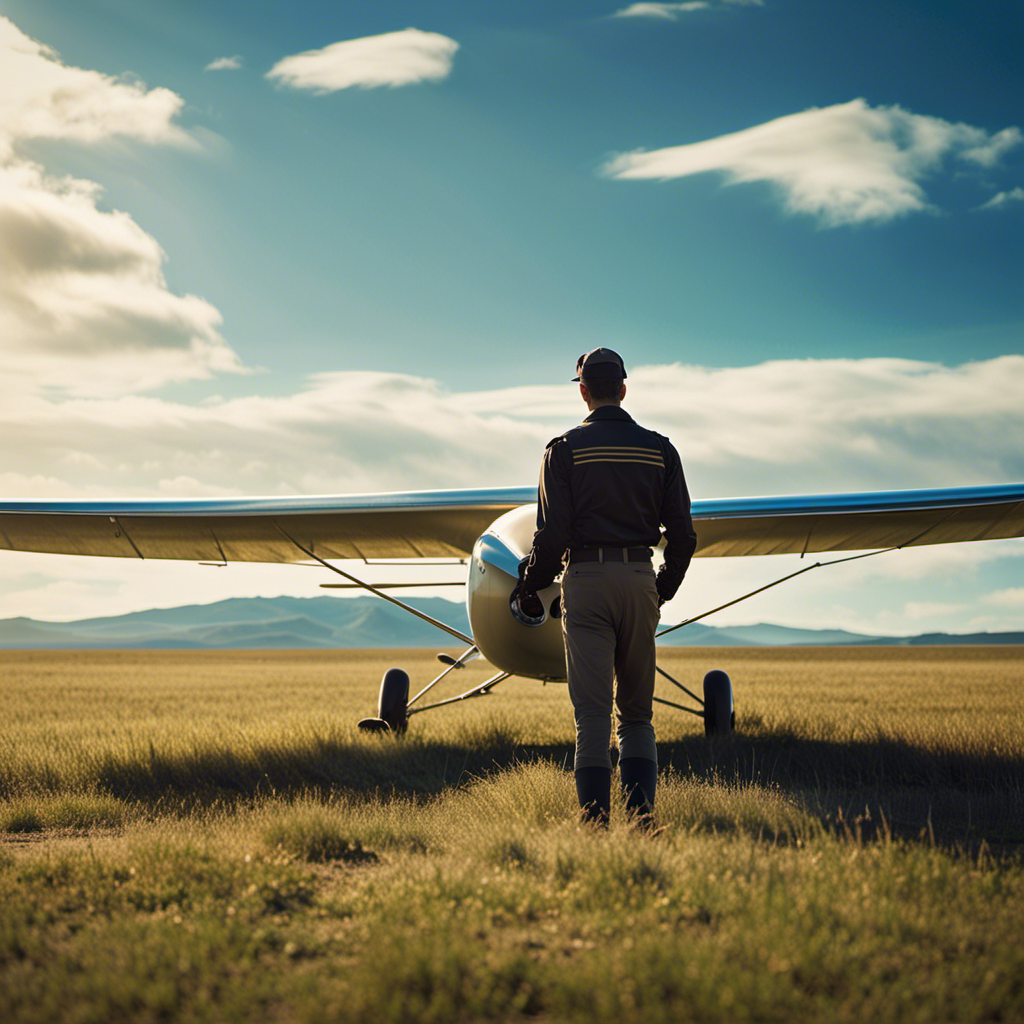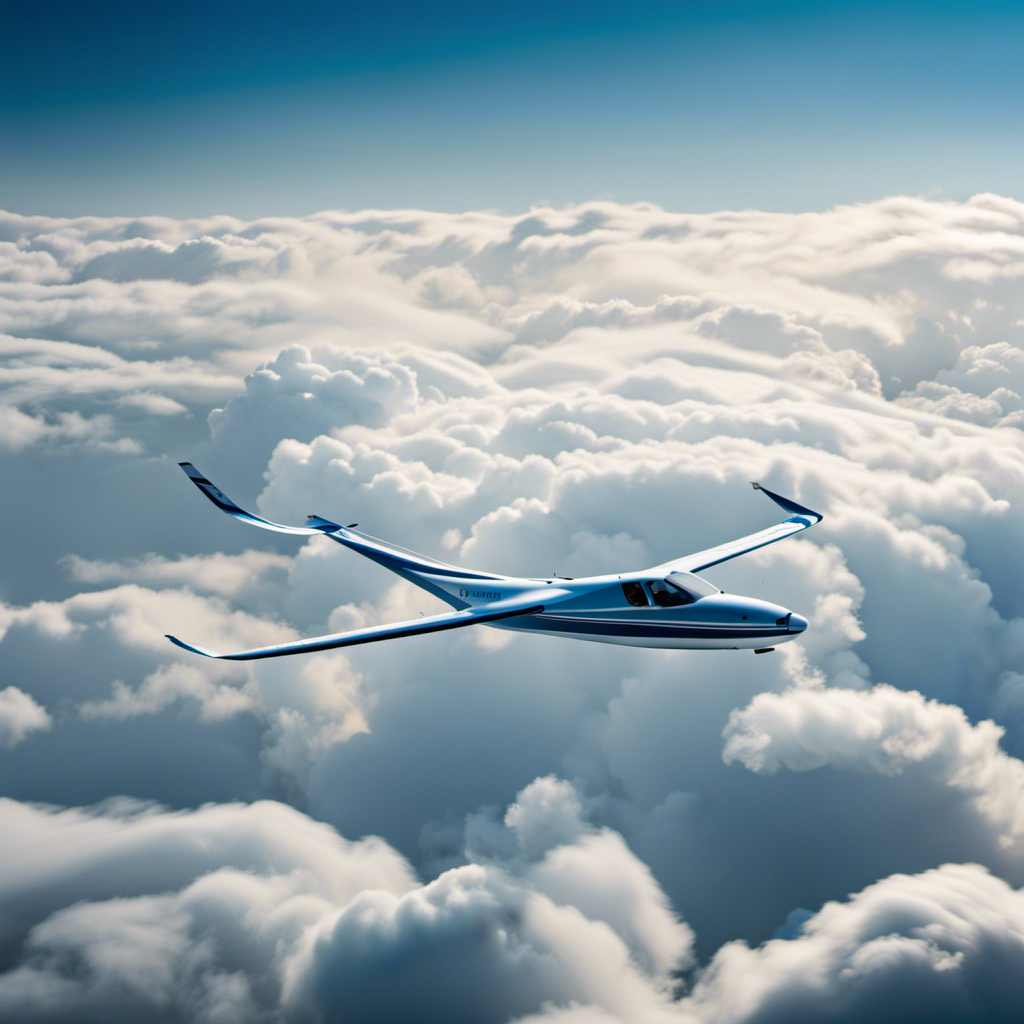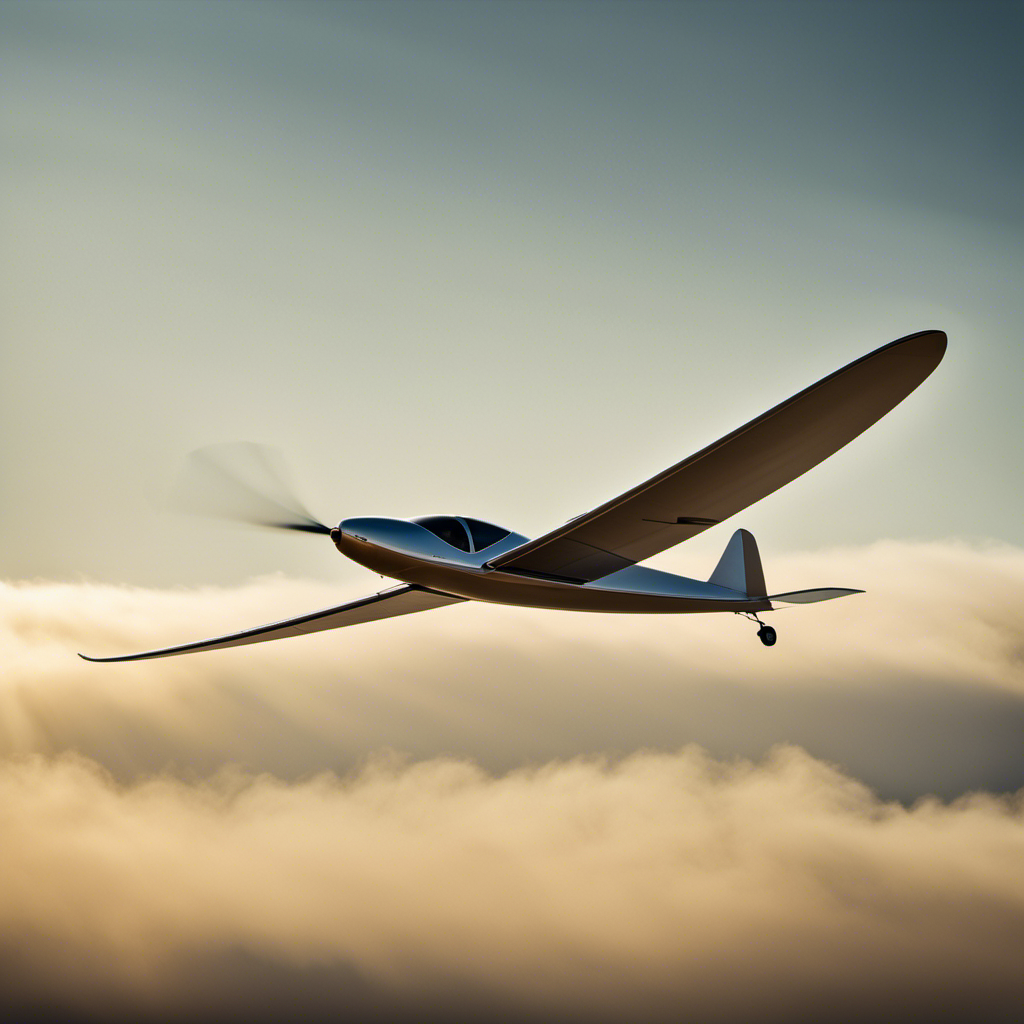As a seasoned glider pilot, I have always believed that flying a glider is like dancing in the sky. The feeling of gracefully soaring through the air, powered solely by the wind and your own skills, is truly exhilarating.
In this article, I will guide you through the art of flying glider planes, from understanding the basics to mastering advanced techniques. Get ready to embark on an extraordinary journey where you’ll learn about launching, soaring, navigation, safety procedures, and more.
Let’s dive into the world of gliding and experience the freedom of flight together.
Key Takeaways
- Gliders rely on lift and gravity, and control surfaces manipulate airflow.
- Launching and landing techniques include tow plane launches, winch launches, and proper communication between pilots.
- Soaring techniques involve utilizing thermals effectively, ridge lift as a source of lift, and mastering techniques for cross country flying.
- Safety and emergency procedures are important, including dealing with unexpected weather conditions and understanding emergency landings and procedures.
Understanding Glider Plane Basics
Understanding the basics of glider planes is essential for learning the art of flying. Glider plane controls play a crucial role in maneuvering the aircraft. The primary controls of a glider include the elevator, ailerons, and rudder. The elevator controls the pitch, allowing the pilot to control the aircraft’s nose-up and nose-down movement. The ailerons control the roll, enabling the pilot to bank the aircraft left or right. Lastly, the rudder controls the yaw, allowing the pilot to control the left or right movement of the aircraft’s tail.
In addition to understanding the controls, it is important to grasp the aerodynamics of glider flight. Gliders rely solely on the forces of lift and gravity to stay aloft. Lift is generated by the wings as air flows over them. The shape of the wings, known as the airfoil, creates a pressure difference that generates lift. By using the control surfaces, pilots can manipulate the airflow and adjust the lift accordingly.
Transitioning into the subsequent section on launching and landing techniques, mastering the glider plane controls and understanding the aerodynamics of flight are essential. However, knowing how to effectively launch and land a glider plane completes the foundation needed for successful glider flying.
Launching and Landing Techniques
When it comes to launching and landing glider planes, there are a few key techniques to consider.
Firstly, tow plane launches involve using a powered aircraft to tow the glider into the air. This method requires coordination and communication between the tow plane pilot and the glider pilot for a smooth takeoff.
Secondly, winch launches involve using a ground-based winch to rapidly reel in a cable attached to the glider, providing the necessary lift for takeoff.
Lastly, landing approaches and touchdown techniques require careful planning and execution to ensure a safe and controlled landing. Pilots must consider factors such as wind direction, speed, and runway conditions to achieve a smooth touchdown and bring the glider to a stop.
Tow plane launches
To launch a glider plane using a tow plane, you’ll need to ensure proper communication between the pilots. Tug pilot training is crucial to ensure safe and efficient launches. Here are four key aerotow techniques to master:
-
Line tension management: Maintaining the right amount of tension in the towline is essential for a smooth takeoff. The tug pilot must be skilled in adjusting the power and attitude of the tow plane to maintain the desired tension.
-
Release procedures: The glider pilot must be well-versed in the release procedures to detach from the tow plane at the appropriate altitude and position. This requires clear communication and coordination between both pilots.
-
Aerotow signals: A standardized set of hand signals is used to communicate between the glider and tug pilots during the launch. Thorough knowledge of these signals is crucial to ensure effective communication.
-
Emergency procedures: In the event of an emergency during the aerotow, both pilots must be familiar with the emergency procedures and know how to react quickly and safely.
Now, let’s explore another method of launching gliders – winch launches.
Winch launches
Using a winch to launch a glider, you’ll experience a rapid acceleration as the cable pulls you into the air. Winch launches are a common method used in glider operations, providing an exhilarating start to your flight. However, proper winch maintenance and understanding winch launching techniques are crucial for a safe and successful launch.
To ensure the winch is in optimal condition, regular inspections and maintenance should be performed. This includes checking the cable tension, inspecting the drum for any signs of wear, and lubricating moving parts. Additionally, it is important to follow proper winch launching techniques, such as maintaining a steady climb angle and releasing the cable at the appropriate altitude.
Emotional Response Table:
| Emotion | Description |
|---|---|
| Excitement | The thrill of rapid acceleration |
| Anticipation | The excitement before the launch |
| Confidence | Trust in the winch and its maintenance |
As you approach the end of your winch launch, it is important to smoothly transition into the subsequent section about landing approaches and touchdown techniques. With a solid foundation in winch launches, you will be well-prepared for a safe and controlled landing.
Landing approaches and touchdown techniques
As you prepare for your landing, it’s crucial to maintain a steady descent and properly execute your touchdown technique. Here are four key points to keep in mind when it comes to landing approaches and touchdown techniques in glider flying:
-
Crosswind landings: When landing in windy conditions, it’s important to compensate for the crosswind by using a technique called crabbing. This involves aligning the aircraft with the runway centerline while keeping the nose pointed into the wind.
-
Flare and touchdown: As you approach the runway, reduce your speed and gently flare the glider to reduce the rate of descent. Aim to touch down smoothly, with the main wheel(s) touching the ground first.
-
Aerodynamic principles: Understanding the aerodynamics of a glider can greatly assist in achieving a successful landing. Keep in mind the effects of lift, drag, and weight distribution throughout the landing process.
-
Practice and experience: Landing techniques improve with practice and experience. Take the time to familiarize yourself with different landing scenarios and practice your techniques regularly.
With these principles in mind, you’ll be well-prepared to execute a successful landing.
Transitioning from landing approaches and touchdown techniques to soaring techniques, let’s now explore the art of gaining altitude and staying aloft in a glider.
Soaring Techniques
You’ll need to understand the principles of lift and how to use thermals effectively to master soaring techniques in glider planes.
Soaring is the art of staying aloft without the aid of an engine, and it is achieved by utilizing the natural sources of lift in the atmosphere. Thermals and ridge lift are the two main sources of lift that glider pilots rely on for soaring.
Thermals are columns of warm air that rise from the ground due to heating by the sun. By carefully circling within a thermal, a glider pilot can gain altitude and stay airborne for extended periods of time.
Ridge lift, on the other hand, is created when wind encounters an obstacle such as a mountain or a hill. As the wind flows over the obstacle, it creates an updraft on the leeward side, providing lift for gliders.
Mastering the techniques of flying in thermals and ridge lift is crucial for cross country flying, where pilots aim to travel long distances by connecting various sources of lift along their route. These techniques require precise control of the glider’s airspeed, bank angle, and energy management in order to maximize the lift and minimize energy loss.
Navigation and Flight Planning
After mastering the techniques of soaring, it is time to delve into the realm of navigation and flight planning. As a glider pilot, understanding how to navigate and plan your flight is essential for successful and efficient flights.
To enhance my skills in this area, I often make use of flight simulation software. These programs allow me to practice various navigation techniques and flight planning scenarios in a virtual environment. By simulating different weather conditions, airspaces, and navigation aids, I can refine my skills and gain confidence in my ability to navigate effectively during actual glider flights.
In addition to honing my skills through simulation, I also participate in glider competitions. These events provide an opportunity to put my navigation and flight planning skills to the test in a competitive setting. Competing against other skilled pilots challenges me to think strategically, make quick decisions, and navigate efficiently to achieve the best possible results.
Transitioning to the next section, safety and emergency procedures are crucial aspects of glider flying that every pilot must be well-versed in.
Safety and Emergency Procedures
When it comes to flying glider planes, safety is of utmost importance. In this discussion, we will delve into three key points that ensure a safe and successful flight.
Firstly, dealing with unexpected weather conditions is crucial, as it can greatly affect the outcome of a flight.
Secondly, understanding emergency landings and procedures is essential for handling unforeseen situations.
Lastly, pre-flight checks and maintenance play a vital role in ensuring the aircraft is in optimal condition before takeoff.
Dealing with unexpected weather conditions
If you’re caught in unexpected weather while flying a glider plane, it’s important to remain calm and make necessary adjustments. The art of flying in high altitudes and navigating through strong winds requires skill and preparedness.
Here are four key steps to deal with unexpected weather conditions:
-
Assess the situation: Evaluate the severity of the weather and understand its impact on your flight path. Look for signs of turbulence, such as dark clouds or sudden changes in wind direction.
-
Adjust your flight plan: Deviate from your original route if necessary. Identify areas with lower wind speeds or seek shelter from the elements. Stay in constant communication with air traffic control for updates and guidance.
-
Maintain control: Use proper control inputs to counteract the effects of strong winds. Adjust your airspeed and control surfaces as needed to maintain stability and prevent loss of control.
-
Monitor weather conditions: Continuously monitor weather updates and adjust your flight plan accordingly. Be prepared to make further adjustments or divert to an alternate landing site if conditions worsen.
In the event of an emergency landing, understanding the proper procedures is crucial. Let’s explore emergency landings and procedures without skipping a beat.
Emergency landings and procedures
Understanding the proper procedures, it’s crucial to know how to handle emergency landings in unforeseen situations. Emergency landing techniques are essential for glider pilots to master, as they allow for a safe and controlled landing when unexpected circumstances arise.
The first step is to assess the situation and identify a suitable landing spot, such as a flat field or an open area. Once the landing site is determined, the pilot must communicate the emergency to the nearest air traffic control facility or nearby pilots using emergency communication procedures. This ensures that help is on the way and that other aircraft in the vicinity are aware of the emergency situation.
Transitioning into the next section about pre-flight checks and maintenance, it is important to emphasize the significance of thorough inspections and regular maintenance to prevent emergencies and ensure a safe flying experience.
Pre-flight checks and maintenance
To ensure a safe and smooth flight, make sure you conduct thorough pre-flight checks and maintenance on your aircraft.
Before every flight, it is crucial to follow a pre-flight inspection checklist. This includes visually inspecting the exterior of the glider for any signs of damage, ensuring the control surfaces are free and move smoothly, and checking the condition of the tires and landing gear.
Additionally, you must inspect the fuel and oil levels, test all electrical systems, and verify the functionality of the instruments and avionics.
Regular maintenance is equally important, including routine engine checks, lubrication of control cables, and inspection of the airframe for any structural issues.
Advanced Glider Maneuvers
You’ll need to master advanced glider maneuvers to take your flying skills to the next level. Here are three key maneuvers that will help you enhance your glider aerobatics and develop effective glider competition strategies:
-
Spin Recovery: One of the most crucial maneuvers in advanced glider flying is spin recovery. Knowing how to safely recover from a spin is essential to ensure your safety and the longevity of your glider. It involves applying the correct control inputs and using the proper techniques to regain control of the aircraft.
-
Dynamic Soaring: This maneuver involves utilizing the energy of the wind to gain altitude and increase speed. By flying in a figure-eight pattern close to the ground, you can take advantage of the wind gradient and create a continuous cycle of energy transfer. This technique is particularly useful in glider competitions, where maximizing speed and altitude is crucial.
-
Aerobatic Figures: To impress the judges in glider competitions, mastering various aerobatic figures is essential. These include loops, rolls, spins, and inverted flight. Each figure requires precise control inputs and coordination to execute them flawlessly.
By mastering these advanced glider maneuvers, you’ll be able to perform impressive aerobatics and implement effective strategies in glider competitions.
Joining a Glider Club or Organization
Once you’ve honed your skills in advanced glider maneuvers, it’s time to consider joining a glider club or organization to further enhance your flying journey. Glider club membership offers a range of benefits that can greatly enrich your experience as a pilot.
Not only do you gain access to a supportive community of fellow enthusiasts, but you also have the opportunity to participate in organized events, competitions, and educational programs. Being part of a glider club allows you to share your passion with like-minded individuals and learn from experienced pilots who can provide valuable guidance and mentorship.
When it comes to finding the right glider club for your experience level, it’s important to consider a few factors. Firstly, research the clubs in your area and determine if they cater to your specific interests and goals. Some clubs may focus more on recreational flying, while others may offer advanced training programs. Additionally, consider the club’s facilities and resources. Do they have well-maintained gliders and equipment? Are there experienced instructors available to provide guidance?
Transitioning into the subsequent section about glider plane maintenance and care, it’s crucial to ensure that your glider is in optimal condition for safe flying. By following proper maintenance procedures and taking care of your glider, you can maximize its performance and longevity.
Glider Plane Maintenance and Care
When it comes to keeping your glider in top shape, it’s important to regularly inspect and maintain its components. Proper glider plane maintenance and care ensure optimal performance and longevity.
Here are some key practices to follow:
-
Glider Plane Storage:
-
Find a suitable storage area that provides protection from the elements, such as a hangar or covered space.
-
Keep the glider plane covered with a protective cover to prevent dust, debris, and UV damage.
-
Glider Plane Cleaning:
-
Regularly clean the exterior of the glider plane using mild soapy water and a soft cloth.
-
Pay special attention to removing any insect residue, as it can damage the paint and affect aerodynamics.
By consistently practicing these maintenance routines, you not only ensure the safety of your glider plane but also enhance its performance and increase its lifespan. Taking the time to properly store and clean your glider plane demonstrates your commitment to its well-being and your passion for flying.
As we move on to discussing glider plane equipment and gear, it’s important to remember that maintaining and caring for your glider plane goes hand in hand with having the right equipment and gear for a successful flight.
Glider Plane Equipment and Gear
Having the proper equipment and gear is essential for a successful and enjoyable flight in a glider plane. As a pilot, I understand the importance of maintaining and upgrading my glider plane equipment to ensure optimal performance and safety. From the cockpit to the wings, every component plays a crucial role in the overall experience of gliding through the sky.
One of the most important pieces of equipment is the parachute, which provides a critical safety measure in case of emergencies. Regular maintenance and inspection of the parachute is necessary to ensure its functionality. Additionally, upgrading to a more advanced parachute system can enhance safety and provide peace of mind during flights.
Another vital piece of gear is the radio communication system. It allows pilots to stay connected with air traffic control and other aircraft, ensuring a smooth and coordinated flight. Regular maintenance and upgrades to the radio system can improve communication clarity and range, enhancing overall safety in the skies.
To give you a deeper understanding of the various glider plane equipment and gear, here is a table showcasing some essential components:
| Component | Purpose | Maintenance |
|---|---|---|
| Parachute | Emergency safety measure | Regular inspection |
| Radio system | Communication with ATC | Regular maintenance, upgrades |
| Cockpit instruments | Flight data monitoring | Regular calibration, upgrades |
| Wing controls | Maneuvering the glider | Regular lubrication, upgrades |
| Landing gear | Ensuring safe landings | Regular inspection, upgrades |
Maintaining and upgrading glider plane equipment and gear is crucial for a safe and enjoyable flight. With proper care and attention to detail, pilots can experience the thrill of gliding through the skies with confidence and peace of mind.
Experiencing the Thrill of Gliding
After ensuring that all my glider plane equipment and gear are in top condition, it’s time to embark on the most exhilarating part of gliding – experiencing the thrill of soaring through the sky. Paragliding adventures offer a unique and breathtaking perspective of the world below.
As I take to the skies, I can’t help but feel a surge of adrenaline and a sense of freedom that is unmatched by any other activity. Here are three reasons why paragliding adventures are truly unforgettable:
-
Spectacular Views: From high above, I am treated to breathtaking panoramic views of the landscapes below. Whether it’s soaring over lush green mountains, gliding above sparkling blue oceans, or floating above picturesque valleys, the scenery is simply awe-inspiring. It’s as if I am painting a moving masterpiece with the tip of my glider.
-
Adrenaline Rush: The feeling of launching off a cliff or a hill and catching the wind beneath my wings is enough to send my heart racing. The rush of adrenaline as I navigate the currents and thermals, and the sheer speed of gliding through the air is an experience like no other. It’s a thrilling adventure that keeps me coming back for more.
-
Inspiration from Famous Glider Pilots: Throughout history, there have been many famous glider pilots who have pushed the boundaries of what is possible in the world of gliding. From Otto Lilienthal, the father of modern gliding, to Steve Fossett, who set numerous world records, these pioneers have inspired countless glider pilots like myself to strive for greatness and explore the endless possibilities of flight.
Frequently Asked Questions
What is the average cost of purchasing and maintaining a glider plane?
The average cost of purchasing a glider plane ranges from $10,000 to $100,000, depending on the model and condition. Maintenance costs include annual inspections, repairs, and storage fees, averaging around $2,000 to $5,000 per year.
Are there any age restrictions for operating a glider plane?
Age limitations for operating a glider plane vary by country, but in the US, you can start training at 14 and solo at 16. Training requirements include ground school, flight instruction, and passing a written exam and flight test.
What are the most common weather conditions that can affect glider flights?
The most common weather conditions that can affect glider flights are strong winds, turbulence, thunderstorms, and low visibility. These conditions can pose a significant risk to flight safety and require careful monitoring and planning.
Can glider planes be used for long-distance flights?
Glider planes have come a long way with technological advancements, allowing for impressive long-distance flights. One noteworthy feat was Steve Fossett’s 2006 flight, where he soared 1,280 km in a glider.
Is it possible to convert a powered aircraft into a glider plane?
Yes, it is possible to convert a powered aircraft into a glider plane through modifications. Converting to a glider offers advantages like increased fuel efficiency, longer flight times, and quieter operation.
Conclusion
In conclusion, mastering the art of flying glider planes is a thrilling journey that requires dedication and skill. From understanding the basics of glider planes to honing launching and landing techniques, there is a sense of both freedom and responsibility that comes with soaring through the skies.
By combining navigation and flight planning with safety procedures, you can ensure a smooth and exhilarating flight every time. Joining a glider club or organization not only provides a sense of community, but also opportunities for growth and learning.
Finally, maintaining and caring for your glider plane, as well as having the right equipment and gear, is essential for a successful gliding experience. So, take to the skies and experience the awe-inspiring beauty of gliding for yourself.
Orion, better known as “Jetstream,” is the voice that brings the stories of the skies to life. His fascination with aviation began at a young age, sparked by his father’s tales of flying and adventure. Orion’s journey into the world of gliding was serendipitous, and from the moment he took his first glider flight, he knew he had found his calling.
